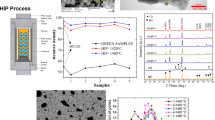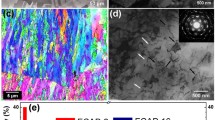Abstract
In the present investigation, the evolution of microstructure and microtexture of pure copper powder during solid state sintering was studied. The powder was compacted using 300 MPa uniaxial die pressure, and the green compact was sintered in an electric furnace at 610 °C, 880 °C, and 1020 °C in hydrogen atmosphere. The temperatures were selected to obtain different dominant densification processes comprised of grain boundary diffusion, surface diffusion, and volume diffusion, respectively. Electron backscatter diffraction (EBSD) studies indicated that there is a distinct evolution of microtexture and microstructure in terms of evolution of grain boundary character distribution (GBCD), size, shape, and morphology of grains and pores. The sample sintered at 610 °C showed poor densification and mechanical properties along with weak random microtexture. However, the sample sintered at 1020 °C showed relatively stronger 〈101〉 fiber texture, better strength, and better hardness. In addition, that sample exhibited a lower fraction of Σ3 twin and high-angle grain boundaries in comparison to samples sintered at lower sintering temperatures. This is attributed to high sintering temperature stimulated bulk diffusion that facilitated migration of grain boundaries and elimination of pores. A detailed analysis of microstructure and grain boundary character indicated the possibility of attempting grain boundary engineering during sintering for optimum processing and property enhancement.











Similar content being viewed by others
Notes
OIM is a trademark of EDAX Inc, Company, Mahwah, NJ
References
A.J. Shaler and J. Wulff: Phys. Rev., 1947, vol. 72, p. 79.
A.J. Shaler and J. Wulff: Phys. Rev., 1948, vol. 73, p. 926.
C. Herring: J. Appl. Phys., 1950, vol. 21, pp. 437–45.
J.H. Dedrick and A. Gerds: J. Appl. Phys., 1949, vol. 20, pp. 1042–44.
B.H. Alexander and R. Balluffi: JOM, 1950, vol. 2, p. 1219.
M.F. Ashby: Acta Metall., 1974, vol. 22, pp. 275–89.
S.J.L. Kang: Sintering: Densification, Grain Growth and Microstructure, Elsevier Science, Amsterdam, 2004.
R.M. German: Powder Metallurgy and Particulate Materals Processing, MPIF, Princeton, NJ, 2005, pp. 219–36.
P. Angerer, E. Neubauer, L.G. Yu, and K.A. Khor: Int. J. Refract. Met. Hard Mater., 2007, vol. 25, pp. 280–85.
P. Duwez and H. Martens: JOM, 1949, vol. 1, pp. 571–77.
G.C. Kuczynski: JOM, 1949, vol. 1, pp. 169–78.
MPIF. Standard Test Methods for Metal Powders and Powder Metallurgy Products Standard 3, 46, 48, MPIF, Princeton, NJ, 1991.
R.M. German and S.J. Park: Handbook of Mathematical Relations in Particulate Materials Processing: Ceramics, Powder Metals, Cermets, Carbides, Hard Materials, and Minerals, Wiley, New York, 2009, vol. 3.
R.M. German: Powder Metallurgy Science, MPIF, Princeton, NJ, 1984.
S. Mandal, A. Bhaduri, and V.S. Sarma: Trans Tech Publications, 2012, vol. 702, pp. 714–17.
W.F. Hosford: Mechanical Behavior of Materials, Cambridge University Press, Cambridge, United Kingdom, 2010, p. 131.
K. Huang: Continuum Theory of Plasticity, Wiley, Hoboken, NJ, 1999, p. 349.
R. German: Sintering: From Empirical Observations to Scientific Principles, Butterworth-Heinemann, Waltham, MA, 2014, p. 283.
G. Gottstein and L.S. Shvindlerman: Grain Boundary Migration in Metals: Thermodynamics, Kinetics, Applications, CRC Press, Boca Raton, FL, 2009, p. 135.
D.P. Field and L.T. Bradford: Acta Mater. 2007, vol. 55, pp. 4233–41.
R.M. German: Reduced Grain Boundary Mobility and the Sintering of Molybdenum, Rensselaer Observatory, Troy, NY, 1984.
Acknowledgment
The authors acknowledge the Department of Material Science and Engineering, Indian Institute of Technology, Kanpur, for the electron microscopy facility.
Author information
Authors and Affiliations
Corresponding author
Additional information
Publisher's Note
Springer Nature remains neutral with regard to jurisdictional claims in published maps and institutional affiliations.
Manuscript submitted October 14, 2018.
Rights and permissions
About this article
Cite this article
Felege, G.N., Gurao, N.P. & Upadhyaya, A. Evolution of Microtexture and Microstructure During Sintering of Copper. Metall Mater Trans A 50, 4193–4204 (2019). https://doi.org/10.1007/s11661-019-05317-7
Received:
Published:
Issue Date:
DOI: https://doi.org/10.1007/s11661-019-05317-7




